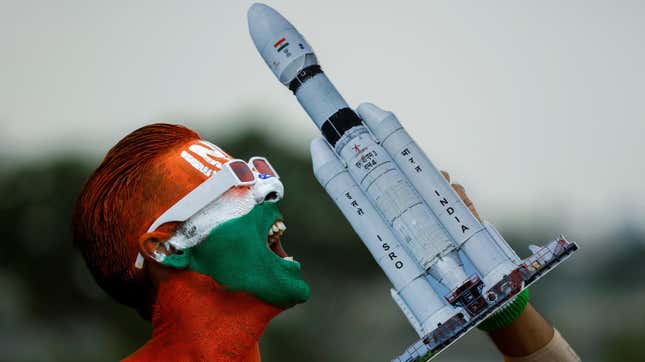
India has become the fourth nation to safely land a robotic explorer on the Moon, and the first to do so near the Moon’s south pole, a region that scientists and explorers are eyeing with deep interest.
The Chandrayaan-3 mission delivered a lander dubbed Vikram and a rover called Pragyan to the lunar surface. This marks the Indian Space Research Organization’s second attempt at a soft landing after the Chandrayaan-2 mission failed in 2019 due to poorly tuned flight software.
It’s not easy to land on the Moon. If you need a reminder, Russia’s Luna-25 lander crashed into the Moon and was destroyed a few days ago after an orbital maneuver gone wrong. Roscosmos, Russia’s space agency, had launched the probe on a mission to beat ISRO to the Moon’s south pole. Instead, the failure highlighted that India is set to outstrip Russia as a space power in the 21st century.
Modi is celebrating at a summit that Putin is sitting out
If the dueling landers weren’t symbolic enough, Indian prime minister Narendra Modi celebrated ISRO’s success at a meeting of leaders of BRICS countries—Brazil, Russia, India, China, and South Africa—that Russian leader Vladimir Putin was forced to skip due to his indictment for war crimes by the International Criminal Court. The isolation imposed on Russia after its invasion of Ukraine has left its space program, already faltering, without the technology and funding to mount ambitious missions in space.
India, meanwhile, has invested in a series of important science missions, and is backing a growing private space sector that seeks to compete with the US and China, the world’s leading producers of space technology.
Measuring space power isn’t straightforward. There’s no doubt that Russia has a rich history of space activities, and its Soyuz rockets remain a global benchmark for reliable access to space. The country still plays a vital role in operating the International Space Station.
But after years of underinvestment by Russia, the cracks are showing, quite literally: Small fissures have been appearing in one of the Russian modules at the habitat, causing it to leak breathable air and forcing complex repair efforts. In 2018, a hole was discovered drilled into a Russian spacecraft, which Roscosmos tried to blame on a US astronaut. Two different Russian spacecraft have been struck by orbital debris, which might be bad luck—except for suspicions that the space junk was generated by destructive tests of Russian anti-satellite missiles. Allegations of corruption at the space agency are common in Russian media.
Russia’s recent track record in space has been poor
As notable is the lack of new activity: None of the country’s space exploration missions announced since 1991 have succeeded, and many have not taken flight. Unlike the Moon missions being mounted by the US, China, and India, Luna-25 was not the first step of a broad campaign, but a last-ditch attempt at relevance. Roscosmos’ budget has been reduced in recent years, and western sanctions aren’t helping: Flying astronauts for other countries and launching satellites helped bring in significant funding for Russian space activities, but now that work is mainly being done by SpaceX.
India, meanwhile, has not only succeeded in recent scientific missions to Mars and the Moon, but is working closely with other space programs to pursue more ambitious activities. Modi recently joined the Artemis Accords on a visit to the US, tying his country to the US Moon program—Chandrayaan-3 relied on the NASA’s deep space radio network to stay in touch with home. ISRO is plotting a joint lunar mission with Japan’s space agency, and collaborating on an advanced radar satellite called NISAR with the US Jet Propulsion Laboratory. It is also preparing new space probes to study Mars and the Sun.
India’s space ambitions are picking up steam
India is also capitalizing on the growing capabilities of the private space sector, with a new space policy designed to encourage their development. The country’s homegrown rockets fly satellites into orbit on commercial terms for companies like OneWeb and other countries like Singapore. Pixxel, a startup building Earth observation satellites with hyperspectral sensors, recently received a $36 million investment from Google, and a handful of other satellite and rocket firms have sprung up in technology-focused Bangalore.
The only area where Russia outstrips India is human spaceflight, one of the most difficult engineering challenges out there. India is plotting to fly people into orbit on a spacecraft called Gaganyaan, but it’s not clear exactly when it will take flight. In the meantime, Indian astronauts are training with NASA at Texas’s Johnson Space Center with an eye toward visiting the ISS in 2024.
The trend, however, favors south Asia. India is getting richer, while Russia’s economy continues to shrink. Russia remains dependent on technology that hails from the first space race, while India is developing new hardware that reflects modern engineering advances. And perhaps most importantly, India is more open to international cooperation and commerce in space. Even if Russia were to find a way to extract itself from Ukraine and regain direct access to global funding and high-tech components needed to build space vehicles, the damage to its economy and the lack of investment would take years to overcome.
With a potential race to the Moon in the offing, India can play a major role. As the US and Europe seek to legitimize its plans for long-term human activity on Earths’ nearest neighbor, Delhi will vie with Beijing to represent the global south in space—and that will shape the future of humanity beyond the Earth for decades to come.